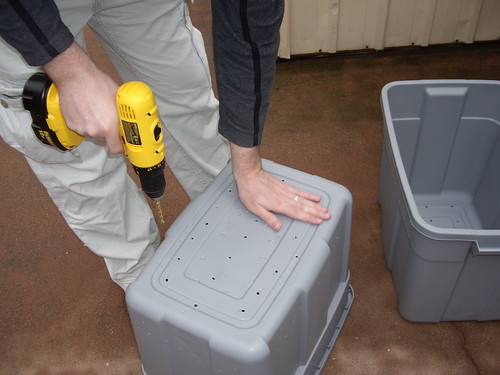How is yardwork like scientific research? Sometimes you set out to accomplish one goal, and find something new and amazing in an area you expected to be mundane.
After months of intentional neglect and lack of watering we have successfully killed off the white clover infestation in the backyard. The plan for this weekend was to till the backyard, remove the cheesy pink scalloped stone border, add some curves with a new border, and re-seed the grass. Ambitious for two people? Yes, but was a long weekend.
Soon after we started tilling the soil we realized that the ivy and shrubbery along the back fence had snuck out into the yard about 3 feet while we weren't looking. We set to work pulling ivy, and trimming back the hedges. We filled up both of our green waste bins in about an hour and made it about halfway across the yard.
In the center of the back wall were a massive bush, a small palm, and a large agave. The palm and the agave had been strangled by the ivy and were mostly dead, so they both came out. We began pulling the ivy out of the bush, and discovered that the bush was not a bush at all. It was just a vine draped over an 8 foot tall metal arch. That's right, we had an 8 foot tall metal arch along our back wall, and it took us 6 months to find it. In the center of the arch was a large jade plant which we also didn't know existed. During the two years of neglect (a year an a half as an empty house and the 6 months since we moved in), the vine spread and grew so that the arch was completely hidden. We now plan on keeping the arch where it is and using it to support some fruiting vines and are rethinking how we are going to set up the rest of the yard.
25.5.09
17.5.09
Worm Bin

We took the instructions for our Worm Composting bin from a fantastic reference The Urban Homestead
Materials:
2 8 gallon tubs
1 cinderblock
Shredded junk mail
1 $5 bag of worms from the farmers market
Our snag: We followed the instructions from the book but had trouble finding worms for sale. The instructions call for 1 pound of worms, which is approximately 1000 of the buggers. I tried several nurseries and bait shops around town, but found none. One day at the farmers market we happened across a guy selling worm castings (nutrient rich worm poop). We told him how much trouble we had finding worms, and he happily sold us 50 worms in a pound of castings for 5 bucks. He told us that they if we fed them, they would multiply and eventually we would have our full pound and that they would eventually be able to keep up with our composting needs. He also said that as long as we didn’t let the worms dry out that they were pretty much bomb proof.
Now 1,000 worms can process about ½ pound of food scraps a day, however 50 worms only process about ½ an ounce of food a day. That is food scraps equivalent to the weight of 13 nickels. So when we put all of our food scraps in we totally overwhelmed our worms. None of the food was disappearing. We decided to lay off the feeding for awhile and let them catch up. When we came back in a few weeks there was mold all over the inside of the bin. Mr. C immediately drilled more vent holes in the side of the bin to help dry it out.
We were both skeptical that worms could have survived living in a mold infested bin for so long and wrote them off as a loss. We recently started looking for a new batch of 1000 worms intending to start over. About one month ago we decided to give worm composting another shot and this time we were going to do it by the book!
This morning we were cleaning out the tool shed and decided it was time to clean out the defunct worm bin. I had given up on trying to find worms locally, and was ready to order them off of the internet. We both braced ourselves for a moldy mess, and lifted off the cover of the bin to find…
Worms! Alive and well. And all of the food had been eaten! We are now feeding them again, and hope to have plenty of compost to use this fall. The plan is to start them off slow, feed them scraps once a week until we notice them disappearing, then slowly up the total to everyday.
Subscribe to:
Posts (Atom)